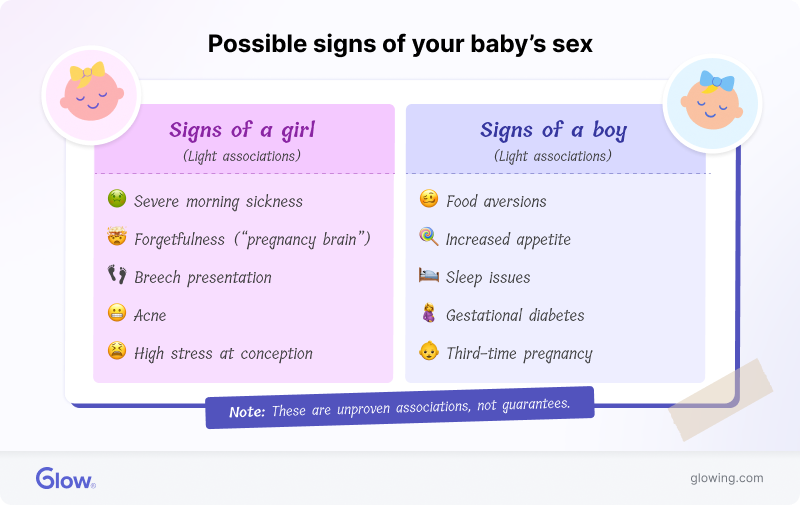Are You Having a Boy or Girl? How to Predict the Sex of Your Baby
If you’re like many moms-to-be, the moment you saw those two lines on your pregnancy test, the first question that popped into your mind was, "Is it a boy or a girl?"

It’s normal to be curious about the sex of your baby and want to know as soon as possible. This is so common that there are dozens of folk beliefs, or old wives’ tales, that you can supposedly use to find out. You’ve probably heard of some of them already: having heartburn means it’s a girl, craving salty snacks means it’s a boy, and so on.
Unfortunately, there’s no evidence for most of these beliefs. Your pregnancy symptoms (or the lack thereof) can’t actually tell you the sex of your growing baby.
That’s the bad news. The good news is that there are plenty of legitimate ways to find out. However, they require visiting a doctor’s office and having an actual test done.
In this article, we’ll separate fact from fiction and tell you how you can really determine the sex of your child-to-be.
What methods can you use to find out if you’re having a boy or girl?
There are four medical tests that will tell you the sex of your baby. These are the only surefire, evidence-backed ways to find out:
1. Cell-free DNA (cfDNA) prenatal screening test
Available: Week 10 or later
Risks: None
This is a blood test that’s mainly designed to screen for chromosomal abnormalities, such as Down syndrome or Edwards syndrome.
To detect these disorders, the cfDNA test analyzes the fetal DNA that’s present in your own blood. This can reveal the presence of the Y chromosome, which indicates you’re carrying a male fetus (a boy).
Your doctor can perform this test as early as your 10th week of pregnancy. You’ll usually get the results back in 7–10 days.
The cfDNA screening is often recommended for mothers over 35 or who have a family history of chromosomal abnormalities. However, it’s risk-free, so even if your doctor doesn’t suggest it, you can ask for it if you really want to know your baby’s sex (or you want to be extra vigilant about screening for those disorders). Just check whether your insurance will cover the procedure first. 1
2. Amniocentesis
Available: Week 15 to week 20 of your pregnancy
Risks: Slight risk of complications, including miscarriage
Amniocentesis is another diagnostic procedure that involves taking a sample of amniotic fluid (which surrounds the baby in your uterus) using a thin needle inserted through your abdomen.
This fluid contains fetal cells. As with the cfDNA test, your doctor can analyze these for genetic abnormalities, as well as infections and—you guessed it—your baby’s sex.
While amniocentesis is very accurate, it carries a risk of complications, increasing the rate of miscarriage by approximately 0.5%. 2 Because of this, your doctor will probably only order it if they think there’s reason to be concerned, not just to find out whether you’re having a boy or girl a few weeks earlier than you otherwise would. However, if you have to get the test for other reasons, that’s a nice bonus.
3. Chorionic villus sampling (CVS)
Available: Week 10 to week 13 of your pregnancy
Risks: Slight risk of complications, including miscarriage
Like amniocentesis, chorionic villus sampling (CVS) involves obtaining a tissue sample for testing. Your doctor will take it from the chorionic villi, which are tiny projections that make up part of your placenta.
This is another test that’s mainly used to screen for chromosomal abnormalities. It’s also similar to amniocentesis in that it carries a small risk of miscarriage, so you shouldn’t get it just to satisfy your curiosity. 2 If your doctor does order it, though, don’t worry—the risks are minor—and as a side benefit, you’ll get extra-early notice about your baby’s gender.
4. Ultrasound (anatomy scan)
Available: Week 18 to week 22 of your pregnancy 3
Risks: None
A pregnancy ultrasound uses high-frequency sound waves to create images of your developing fetus. You may get more than one ultrasound over the course of your pregnancy, mainly to assess your baby’s growth and health.
Because ultrasounds create an actual picture of your baby, your sonographer (the ultrasound technician) can also use them to determine your baby’s sex. All they have to do is look for their external genitalia.
Most babies are developed enough for this to be possible between weeks 18 and 22. The routine ultrasound you’ll have around this time is known as the anatomy scan or the gender scan. Because it’s a nearly universal procedure, this is the most common time when most parents find out their baby’s sex (assuming they want to be told).
Unfortunately, not all babies cooperate during this scan. If yours happens to be positioned in a way that hides their genitalia, you’ll just have to wait until your next ultrasound to find out whether they’re a boy or girl.
Pregnancy symptoms that (might) suggest your baby’s sex
If your baby was feeling shy during your last ultrasound and you didn’t get any of the other tests we listed, it makes sense if you’re casting around for other ways to find out if you have a boy or girl.
There are a few pregnancy symptoms that studies suggest might correlate with sex. None have been conclusively studied, and all of the correlations are quite limited. At best, if you have these symptoms, you can take them as mild hints—but don’t get carried away.
5 symptoms potentially associated with carrying a girl
There’s at least some evidence suggesting that if you have these symptoms, you’re more likely to be carrying a daughter.
1. Severe morning sickness (hyperemesis gravidarum)
Many pregnant women experience nausea and vomiting, called morning sickness, in their first trimesters.
The most severe form of this is called hyperemesis gravidarum. It’s characterized by much more intense and persistent vomiting, potentially to the point of requiring treatment.
Some research suggests there’s a link between hyperemesis gravidarum and carrying a female fetus. The theory is that higher levels of the pregnancy hormone hCG, which female fetuses may produce in greater amounts, contribute to more severe nausea. 4 5
2. Cognitive changes / forgetfulness (“pregnancy brain”)
It isn’t just a joke: pregnancy really can lead to forgetfulness, or “pregnancy brain,” which can start as early as the first trimester. Some studies have explored whether this is linked to fetal sex. 6
There might be a correlation between carrying a girl and performing more poorly on certain memory tests. However, the studies investigating this have been small and limited, so as with the other entries in this section, you should take this with a grain of salt.
3. Breech presentation (late pregnancy)
If your baby is in a breech position (feet or buttocks first) late in your pregnancy—after 32 weeks—some studies suggest they might be a little more likely to be a girl. 7
However, many breech babies are also boys, and either way, by the time you reach this point, you’ll probably have found out the sex of your little one through one of your ultrasounds, anyway.
4. Acne
One very small study found a link between pregnancy acne during the second and third trimesters and carrying a girl. However, even if this holds up, it almost certainly won’t turn out to be a reliable predictor, since hormonal fluctuations may cause acne regardless of your baby’s sex. 8
5. Elevated stress levels at conception
This last one isn’t a “symptom,” but research suggests that higher stress around the time of conception—as measured by your levels of cortisol, a stress hormone—may be linked to a slightly higher chance of conceiving a girl. 9
One theory suggests that female fetuses may be more resilient to stressful prenatal environments, which would make this an evolutionary adaptation. Yet again, the research on this is far from conclusive.
5 symptoms potentially associated with carrying a boy
In a similar vein, these are signs that you could have a baby boy growing inside of you:
1. Food aversions
While many pregnant women find themselves craving certain foods (and sometimes surprising themselves with exactly what they’re hungering for), some also develop the reverse symptom: strong aversions to tastes or smells.
A bit of research suggests that experiencing more intense food aversions during pregnancy might be associated with carrying a boy. The theory is that this is due to your brain trying to protect the more vulnerable male fetus from harmful substances. 10
2. Gestational diabetes
Gestational diabetes is a condition that can develop during pregnancy. It’s characterized by high blood sugar levels.
Some studies have found a tentative correlation between gestational diabetes and carrying a male fetus. 11 If this ends up being true, it’s not clear why that would be the case, although, as with so many things during pregnancy, there’s a good chance it has something to do with hormonal fluctuations.
Be aware that many women don’t have noticeable gestational diabetes symptoms. You’ll only know for sure whether you have it after getting your glucose screenings and tests, which you’ll have between 24 and 28 weeks.
3. Sleep-disordered breathing
Increased snoring and other forms of sleep-disordered breathing, such as sleep apnea, have been linked in some studies to carrying a boy. One possible explanation involves lower levels of the pregnancy hormone PAPP-A (pregnancy-associated plasma protein A), which has been associated with both male fetuses and sleep issues. 12
4. Eating more / feeling extra hungry
Some studies suggest a link between higher calorie intake (both around the time of conception and throughout your pregnancy) and an increased chance of having a boy. If your pregnancy munchies are particularly strong, you might be a little more likely to have a son than a daughter. 13 14
5. This is your third pregnancy
We’ll cap off this list with another possible correlation that isn’t actually a symptom, per se. One study suggests that third-time mothers may have a slightly higher likelihood of having a boy. Why this would be is anyone’s guess, and in lieu of further research, there’s no way to be sure whether this is a genuine correlation or not. 15
Just to reiterate, everything in this list is a faint association, not a guarantee. What’s more, while each entry is backed by research, they aren’t backed by very much research. If you really want to know the sex of your baby for sure, you’ll have to spring for one of the medical tests we listed further up, or just wait for your next ultrasound.

Debunking common myths and old wives' tales
At last, this brings us to the common myths and old wives’ tales surrounding gender prediction.
Many people believe you can use these signs and methods to tell whether you have a boy or girl. While some of these can be fun, they aren’t supported by any scientific evidence. If you give any of them a try, treat it purely as entertainment.
1. Fetal heart rate
Many people believe that a fetal heart rate below 140 beats per minute indicates you’re having a boy, while a rate above 140 indicates a girl.
However, studies have shown no significant difference in fetal heart rates between male and female fetuses. Normal fetal heart rates fluctuate between 110 and 160 beats per minute, regardless of sex. 16
2. Carrying position (high/low)
There’s another popular idea that carrying “high” (i.e., developing a baby bump higher up on your abdomen) means you have a girl. Of course, the inverse is also supposed to be true: carrying low means you’re having a boy.
This is another myth. The shape and position of your bump are determined by your abdominal muscle tone, the baby’s position in the uterus, your body type, and other boring disappointingly commonplace factors, not the baby’s sex.
3. Linea nigra
The linea nigra is a darkened line that will appear on your abdomen during pregnancy. Some believe that if the line only extends to your navel, you’re pregnant with a girl, whereas if it reaches above the navel, it’s a boy.
Unfortunately, this change in pigmentation is caused by hormonal fluctuations and has nothing to do with your embryo or fetus’s sex.
4. Nipple color
The myth that darker nipples indicate a boy is also unfounded. Whether and how much your nipples darken is caused by your hormonal fluctuations (you’re probably sensing a pattern here) and have nothing to do with sex or gender.
5. Food cravings (sweet/salty)
This is a big one. If you’re particularly craving sweet foods, a lot of people will claim that means you’re having a girl. Craving salty or savory food is supposed to mean the opposite.
It isn’t hard to guess why this is (don’t most people associate sweetness with girls?), but research hasn’t found any correlation between food cravings and fetal sex. That said, your cravings might have something to do with your nutritional needs, so feel free to indulge them, at least in moderation.
6. Cold feet
Some believe that having cold feet during pregnancy means you’re carrying a boy. There’s no scientific basis for this claim, although it’s certainly true that your circulation can change while you’re pregnant, affecting your body temperature.
7. Heartburn
Another old wives’ tale holds that heartburn (acid reflux) during pregnancy means you’re carrying a girl. The idea is that this has something to do with the baby having hair.
In reality, heartburn can start as early as the first trimester of pregnancy, well before your baby is developed enough to grow hair at all. It’s mainly caused by your growing uterus pressing on your stomach and hormonal changes relaxing some of your muscles.
It’s actually true that some studies have suggested a link between later-pregnancy heartburn severity and the presence of baby hair when an infant is born. 17 Unfortunately, it isn’t true that girl babies are more likely to have a full head of hair in the womb, even if they’re more likely to wear their hair longer later in life.
8. Urine color
The idea that darker urine indicates a girl and lighter urine indicates a boy isn’t true, either. It’s a good idea to pay attention to your urine, but that’s just because darker urine can be a sign of dehydration. If the toilet bowl is more of a caramel than a lemonade color after you pee, that doesn’t mean you’re having a daughter—it just means you need to pound back a couple glasses of water.
9. Chinese gender predictor chart
The Chinese gender predictor chart is a tool that claims to predict your child’s sex based on:
- Your lunar age when you conceived
- The month of conception
This method is a folk belief, not a scientific test. If it sounds fun, by all means give it a try, but again, don’t take it too seriously.
10. Other folk beliefs
There’s a handful of other old wives’ tales about figuring out the sex of your baby. You’re supposed to pay attention to:
- Breast symmetry: This consists of checking whether your right breast has swollen more than your left one, or vice versa. (If your right breast has grown more, you’re supposed to be having a girl.)
- Dry hands: Some people also believe that if your hands are dry and in need of lotion, you’re having a boy.
- Mood swings: More intense mood swings are said to mean you’re going to have a daughter.
- The ring test: This consists of dangling a ring over your belly and seeing whether it moves back and forth (meaning you’re carrying a boy) or in a circle (a girl).
- The key test: If you pick up a key, grabbing it by the long end apparently means you’re having a boy. Grabbing the round end means it’s a girl.
- Placenta location: According to the Ramzi theory, if you look at an ultrasound and your placenta is on the right side of your uterus, it means you’re having a boy. If it’s on the left, you’re having a girl.
It probably goes without saying that these myths are exactly that. Again, entertaining them can be fun, but if you take them too seriously, you could be setting yourself up for disappointment.
Final thoughts
Just to recap, although some at-home methods of guessing your baby’s sex have more scientific backing than others, there are only four ways that are on really firm footing (and even these aren’t guaranteed to be 100% accurate):
- cfDNA screening
- Amniocentesis
- Chorionic villus sampling
- Ultrasound
These methods become viable toward the end of your first trimester and in the middle of your second. Even if you’re impatient to know—and if you are, you’re in good company!—you won’t have to wait all that long.
Of course, if you decide you’d rather not be told by an ultrasound sonographer or anyone else in a clinical setting, that’s perfectly fine. Many expecting moms ultimately decide to wait and be surprised when their baby finally comes.
Article Sources
- MedlinePlus. "Prenatal Cell-Free DNA Screening" Retrieved April 15, 2025.
- Centers for Disease Control and Prevention. "Chorionic Villus Sampling and Amniocentesis: Recommendations for Prenatal Counseling" Retrieved April 15, 2025.
- Cleveland Clinic. "20-Week Ultrasound (Anatomy Scan)" Retrieved April 15, 2025.
- The Journal of Maternal-Fetal & Neonatal Medicine. "Pregnancy outcome in hyperemesis gravidarum--the role of fetal gender" Retrieved April 15, 2025.
- Journal of Obstetrics and Gynaecology. "Hyperemesis gravidarum and fetal gender: a retrospective study" Retrieved April 15, 2025.
- Neuroreport. "Selective and persistent effect of foetal sex on cognition in pregnant women" Retrieved April 15, 2025.
- Acta Obstetricia et Gynecologica Scandinavica. "Breech presentation: its predictors and consequences. An analysis of the Hungarian Tauffer Obstetric Database (1996–2011)" Retrieved April 15, 2025.
- Journal of the European Academy of Dermatology and Venereology. "Inflammatory facial acne during uncomplicated pregnancy and post-partum in adult women: a preliminary hospital-based prospective observational study of 35 cases from Taiwan" Retrieved April 15, 2025.
- Journal of Developmental Origins of Health and Disease. "Hair cortisol levels in pregnancy as a possible determinant of fetal sex: a longitudinal study" Retrieved April 15, 2025.
- Physiology & Behavior. "Disgust in pregnancy and fetus sex—Longitudinal study" Retrieved April 15, 2025.
- Diabetic Medicine. "Sex ratio variations among the offspring of women with diabetes in pregnancy" Retrieved April 15, 2025.
- Sage Journals. "Exploring Fetal Sex as a Risk Factor for Sleep Disordered Breathing and Its Complications in Pregnancy" Retrieved April 15, 2025.
- The BMJ. "Average energy intake among pregnant women carrying a boy compared with a girl" Retrieved April 15, 2025.
- The Royal Society. "You are what your mother eats: evidence for maternal preconception diet influencing foetal sex in humans" Retrieved April 15, 2025.
- Scientific Reports. "Factors influencing sex ratio at birth in Krosno, Poland" Retrieved April 15, 2025.
- Johns Hopkins Medicine. "Fetal Heart Monitoring" Retrieved April 15, 2025.
- Birth (Berkeley, Calif.). "Pregnancy folklore revisited: the case of heartburn and hair" Retrieved April 15, 2025.







